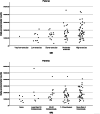Utility of single-item questions to assess physical inactivity in patients with chronic heart failure
- PMID: 32372549
- PMCID: PMC7373918
- DOI: 10.1002/ehf2.12709
Utility of single-item questions to assess physical inactivity in patients with chronic heart failure
Abstract
Aim: The purpose of this study was to explore the utility of two single-item self-report (SR) questions to assess physical inactivity in patients with heart failure (HF).
Methods and results: This is a cross-sectional study using data from 106 patients with HF equipped with accelerometers for 1 week each. Two SR items relating to physical activity were also collected. Correlations between accelerometer activity counts and the SR items were analysed. Patients were classified as physically active or inactive on the basis of accelerometer counts, and the SR items were used to try to predict that classification. Finally, patients were classified as having high self-reported physical activity or low self-reported physical activity, on the basis of the SR items, and the resulting groups were analysed for differences in actual physical activity. There were significant but weak correlations between the SR items and accelerometer counts: ρ = 0.24, P = 0.016 for SR1 and ρ = 0.21, P = 0.033 for SR2. Using SR items to predict whether a patient was physically active or inactive produced an area under the curve of 0.62 for SR1, with a specificity of 92% and a sensitivity of 30%. When dividing patients into groups on the basis of SR1, there was a significant difference of 1583 steps per day, or 49% more steps in the high self-reported physical activity group (P < 0.001).
Conclusions: There might be utility in the single SR question for high-specificity screening of large populations to identify physically inactive patients in order to assign therapeutic interventions efficiently where resources are limited.
Keywords: Accelerometer; Heart failure; Physical inactivity; Self-report.
© 2020 The Authors. ESC Heart Failure published by John Wiley & Sons Ltd on behalf of the European Society of Cardiology.
Conflict of interest statement
None to report.
Figures



Similar articles
-
Physical Functioning, Physical Activity, Exercise Self-Efficacy, and Quality of Life Among Individuals With Chronic Heart Failure in Korea: A Cross-Sectional Descriptive Study.J Nurs Res. 2017 Apr;25(2):131-139. doi: 10.1097/JNR.0000000000000150. J Nurs Res. 2017. PMID: 28277393
-
Accelerometer and Survey Data on Patterns of Physical Inactivity in New York City and the United States.Public Health Rep. 2019 May/Jun;134(3):293-299. doi: 10.1177/0033354919841855. Epub 2019 Apr 5. Public Health Rep. 2019. PMID: 30951644 Free PMC article.
-
Impact of Physical Inactivity on Mortality in Patients With Heart Failure.Am J Cardiol. 2016 Apr 1;117(7):1135-43. doi: 10.1016/j.amjcard.2015.12.060. Epub 2016 Jan 18. Am J Cardiol. 2016. PMID: 26853954 Free PMC article. Clinical Trial.
-
[Physical inactivity versus sedentariness: analysis of the chilean national health survey 2016-2017].Rev Med Chil. 2021 Jan;149(1):103-109. doi: 10.4067/S0034-98872021000100103. Rev Med Chil. 2021. PMID: 34106141 Spanish.
-
Short- and Long-term Effects of a Mobile Phone App in Conjunction With Brief In-Person Counseling on Physical Activity Among Physically Inactive Women: The mPED Randomized Clinical Trial.JAMA Netw Open. 2019 May 3;2(5):e194281. doi: 10.1001/jamanetworkopen.2019.4281. JAMA Netw Open. 2019. PMID: 31125101 Free PMC article. Clinical Trial.
Cited by
-
Validity, reliability, and readability of single-item and short physical activity questionnaires for use in surveillance: A systematic review.PLoS One. 2024 Mar 12;19(3):e0300003. doi: 10.1371/journal.pone.0300003. eCollection 2024. PLoS One. 2024. PMID: 38470871 Free PMC article.
-
Usability and feasibility analysis of an mHealth-tool for supporting physical activity in people with heart failure.BMC Med Inform Decis Mak. 2024 Feb 12;24(1):44. doi: 10.1186/s12911-024-02452-z. BMC Med Inform Decis Mak. 2024. PMID: 38347499 Free PMC article.
-
Exploring user experience: A qualitative analysis of the use of a physical activity support app for people with heart failure.PLoS One. 2025 May 22;20(5):e0309577. doi: 10.1371/journal.pone.0309577. eCollection 2025. PLoS One. 2025. PMID: 40402948 Free PMC article.
-
Physical Inactivity Before Surgery for Lumbar Spinal Stenosis Is Associated With Inferior Outcomes at 1-Year Follow-Up: A Cohort Study.Int J Spine Surg. 2022 Sep;16(5):916-920. doi: 10.14444/8347. Epub 2022 Sep 6. Int J Spine Surg. 2022. PMID: 36302609 Free PMC article.
-
A scoping review on advancements in noninvasive wearable technology for heart failure management.NPJ Digit Med. 2024 Oct 12;7(1):279. doi: 10.1038/s41746-024-01268-5. NPJ Digit Med. 2024. PMID: 39396094 Free PMC article.
References
-
- Aggarwal M, Bozkurt B, Panjrath G, Aggarwal B, Ostfeld RJ, Barnard ND, Gaggin H, Freeman AM, Allen K, Madan S, Massera D, Litwin SE, American College of Cardiology's N, Lifestyle Committee of the Prevention of Cardiovascular Disease C. Lifestyle modifications for preventing and treating heart failure. J Am Coll Cardiol 2018;72():2391–2405. - PubMed
-
- Organization WH . Global Recommendations on Physical Activity for Health. WHO Guidelines Approved by the Guidelines Review Committee. Geneva: 2010.
-
- Bauman A, Merom D, Bull FC, Buchner DM, Fiatarone Singh MA. Updating the evidence for physical activity: summative reviews of the epidemiological evidence, prevalence, and interventions to promote “active aging”. Gerontologist 2016; 56: S268–S280. - PubMed
-
- Downing J, Balady GJ. The role of exercise training in heart failure. J Am Coll Cardiol 2011; 58: 561–569. - PubMed
Publication types
MeSH terms
Grants and funding
LinkOut - more resources
Full Text Sources
Medical
Research Materials
Miscellaneous

